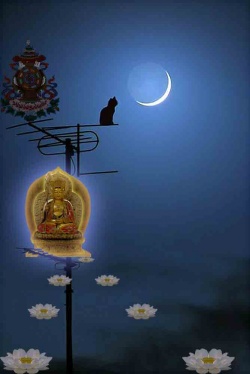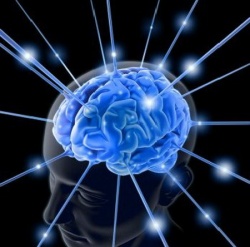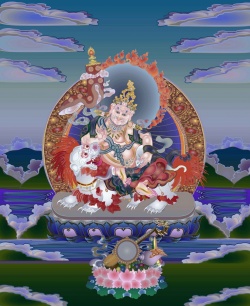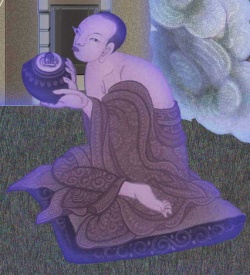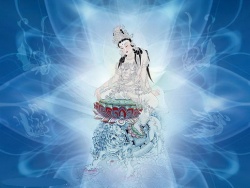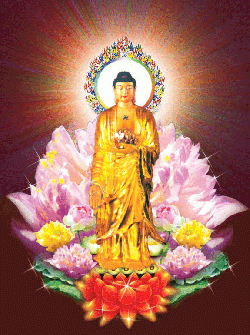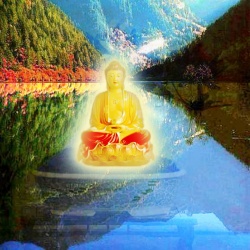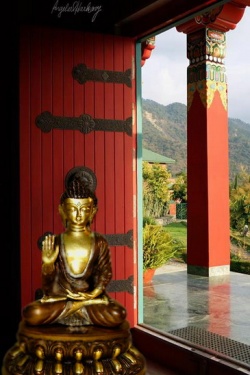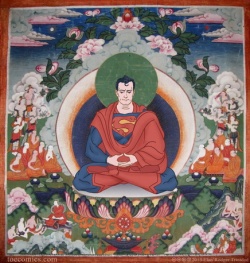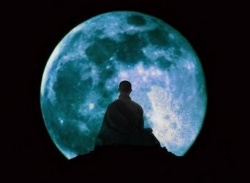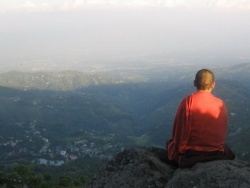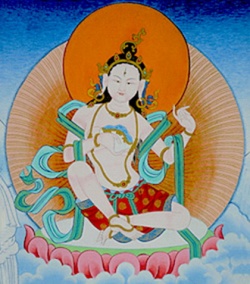Five hindrances
In the Buddhist tradition, the five hindrances (Sanskrit: pañca nivāraṇa; Pali: pañca nīvaraṇāni) are identified as mental factors that hinder progress in meditation and in our daily lives. In the Theravada tradition, these factors are identified specifically as obstacles to the jhānas (stages of concentration) within meditation practice. Within the Mahayana tradition, the five hindrances are identified as obstacles to samatha (tranquility) meditation. Contemporary Insight Meditation teachers identify the five hindrances as obstacles to mindfulness meditation.
The five hindrances are:
Sensory desire (kāmacchanda): the particular type of wanting that seeks for happiness through the five senses of sight, sound, smell, taste and physical feeling.
Ill-will (vyāpāda; also spelled byāpāda): all kinds of thought related to wanting to reject, feelings of hostility, resentment, hatred and bitterness.
Sloth-torpor (thīna-middha): heaviness of body and dullness of mind which drag one down into disabling inertia and thick depression.
Restlessness-worry (uddhacca-kukkucca): the inability to calm the mind.
Doubt (vicikicchā): lack of conviction or trust.
Within the Buddhist traditions
The five hindrances are identified in the major Buddhist traditions of Theravada Buddhism and Mahayana Buddhism, as well in the contemporary Insight Meditation tradition. But the hindrances are presented differently within these different traditions, depending upon the way each tradition teaches the practice of meditation.
Contemporary Insight Meditation
Contemporary Insight Meditation teacher Gil Fronsdal describes the hindrances as "a very important list of mental states that have a big impact on meditation practice and people’s daily lives." Fronsdale emphasizes that it is important not to see the hindrances as personal failings. All human beings have them. A big part of mindfulness meditation is to learn about these hindrances in order to become free of them. Therefore, Fronsdale states, the goal is to not dismiss them, but to study them and understand them really well.
Contemporary teacher Jack Kornfield described the five hindrances as "difficult energies which arise in the mind and in one's life as a part of meditation practice."
Theravada tradition
Contemporary Theravada scholar Nina van Gorkom states: "The hindrances are obstructions, overwhelming the mind, weakening insight.[...] The hindrances obstruct the development of what is wholesome."[web 4]
Within the Theravada tradition, the five hindrances are identified specifically as obstacles to the jhānas (stages of concentration) within meditation. For example, contemporary Theravada teacher Ajahn Brahmavamso states:[web 1]
The deliberate idea of overcoming these five hindrances is important because it is the five hindrances that block the door to both the jhānas, and wisdom. It’s the five hindrances that fuel avijjā. The Buddha said that they’re the nutriments, the food of delusion.
Ajahn Brahmavamso emphasizes that any obstacle that arises in meditation can be identified as one of the five hindrances; he states:
Any problem which arises in meditation will be one of these Five Hindrances, or a combination. So, if one experiences any difficulty, use the scheme of the Five Hindrances as a 'check list' to identify the main problem. Then you will know the appropriate remedy, apply it carefully, and go beyond the obstacle into deeper meditation. When the Five Hindrances are fully overcome, there is no barrier between the meditator and the bliss of Jhana. Therefore, the certain test that these Five Hindrances are really overcome is the ability to access Jhana.
Mahayana tradition
Within the Mahayana tradition, the five hindrances are typically identified as obstacles to samatha meditation (also referred to as tranquility meditation).
Overcoming the hindrances
All of the Buddhist traditions emphasize that the hindrances are overcome by investigating and understanding them. For example, contemporary Theravada teacher Ajahn Sumedho states:
In meditation one develops an understanding of the Five Hindrances -- how, when one of them is present, you investigate it, you understand it, you accept its presence and you learn how to deal with it. Sometimes you can just tell it to go away and it goes; sometimes you just have to allow it to be there till it wears out.
Contemporary Insight Meditation teacher Gil Fronsdal emphasizes that to be a good student of the hindrances, you must be very patient with them and not be dismissive of them. When they arise, you must stop for them. Fronsdal states that a bumper sticker for this type of training could be “I stop for the hindrances.” You don’t indulge them, Fronsdal states, you become interested and study them.
The Insight Meditation tradition teaches the RAIN formula for investigating the hindrances:
R: Recognize it.
A: Accept it.
I: Investigate it, be curious. What is it like?
N: Non-identification. This is just a passing process that comes and goes, not who we are.
The hindrances individually
Sensory desire (kamacchanda)
The hindrance of sensory desire (kamacchanda) is latching onto thoughts or feelings based on the pleasures of the five senses.
Ajahn Brahmavamso (1999) states: "Sensory desire refers to that particular type of wanting that seeks for happiness through the five senses of sight, sound, smell, taste and physical feeling. It specifically excludes any aspiration for happiness through the sixth sense of mind alone. In its extreme form, sensory desire is an obsession to find pleasure in such things as sexual intimacy, good food or fine music. But it also includes the desire to replace irritating or even painful five-sense experiences with pleasant ones, i.e. the desire for sensory comfort."
Ajahn Brahmavamso (2001) states: "[...] kāma chanda are anything from the extremes of lust to just being concerned with how the body is doing. Thinking about the letter that you have to write afterwards, about the rain pattering on your roof, about your kutī monk's hut, or what needs to be built next, or were you are going to next, that’s all in the kāmaloka, the world of the senses, that’s all kāma chanda. It’s also kāma vitakka, or the thoughts about those things, about family, about health, about coming here, going there, and thoughts about words.
Traleg Kyabgon states: "This term alludes to the minds tendency to latch on to something that attracts it--a thought, a visual object, or a particular emotion. When we allow the mind to indulge in such attractions, we lose our concentration. So we need to apply mindfulness and be aware of how the mind operates; we don't necessarily have to suppress all these things arising in the mind, but we should take notice of them and see how the mind behaves, how it automatically grabs onto this and that."
Analogy
The hindrance of sensory desire is compared to taking out a loan – any pleasure one experiences through these five senses must be repaid through the unpleasantness of separation or loss which invariably follow when the pleasure is used up. There is also interest to be repaid on the loan. Thus, the Buddha said that the pleasure is small compared to the suffering repaid.
Antidote
In order to overcome the hindrance of sensory desire (kamacchanda), the meditator must first apply mindfulness and recognize that the hindrance is present. Then one must look at the hindrance, analyze it, make it the object of our meditation, experience it fully. The meditator can then apply specific techniques such as contemplating the impermanence of the pleasant desire.
Ajahn Brahmavamso emphasizes the technique of letting go of concern for the body and the five senses completely; he states:
In meditation, one transcends sensory desire for the period by letting go of concern for this body and its five sense activity. Some imagine that the five senses are there to serve and protect the body, but the truth is that the body is there to serve the five senses as they play in the world ever seeking delight. Indeed, the Lord Buddha once said, "The five senses ARE the world" and to leave the world, to enjoy the other worldly bliss of Jhana, one must give up for a time ALL concern for the body and its five senses.
Etymology
Kamacchanda can be compared to giving your approval for kāma-based thoughts and emotions to remain in your mind. It is allowing these thoughts to occupy your mind. Ajahn Brahmavamso explains:
In the Pāli term kāma chanda, chanda is what you have to do if you cannot attend a meeting of the community of monks, and you want to give approval and agreement to what’s happening there, you give your chanda to go ahead in your absence. It’s agreement, approval, consent, and it’s much more subtle than mere desire. This means that you are buying into, giving in to this, you want it, you approve of it, and you allow it to happen. In the same way that we have chanda in the Vinaya, we have that kāma chanda. It’s as if you give your approval for the sensory world to be in your consciousness, in your mind, you accept it, approve of it, and you play with it, that’s all chanda. It’s letting it completely occupy the mind, and it’s much more subtle than just mere desire. The kāma part of kāma chanda, that’s all that is comprised in kāmaloka, the world of the five senses, which goes from the hell realms, the animal realms, the ghost realms, the human realm, and the Deva realms, to everything that is concerned with those kāmaloka realms. Kāma Chanda is acceptance, agreement, and consent for that world to occupy you.
Ill will (vyapada)
The hindrance of ill will (vyapada) is latching onto thoughts or feelings based on anger, resentment, hostility, bitterness, etc.
Ajahn Brahmavamso states: "Ill will refers to the desire to punish, hurt or destroy. It includes sheer hatred of a person, or even a situation, and it can generate so much energy that it is both seductive and addictive. At the time, it always appears justified for such is its power that it easily corrupts our ability to judge fairly. It also includes ill will towards oneself, otherwise known as guilt, which denies oneself any possibility of happiness. In meditation, ill will can appear as dislike towards the meditation object itself, rejecting it so that one's attention is forced to wander elsewhere."
Traleg Kyabgon states: "The second hindrance is ill will; it is the opposite of the first hindrance, being brought about by aversion rather than attraction. Ill will refers to all kinds of thought related to wanting to reject, feelings of hostility, resentment, hatred and bitterness. When they arise, we should take note of them, not necessarily suppressing them, but seeing how they arise."
Analogy
The hindrance of ill will is compared to being sick. Just as sickness denies one the freedom and happiness of health, so ill will denies one the freedom and happiness of peace.
Antidote
The antidote to the hindrance of ill will (vyapada) is meditation on loving kindness (metta). Ajahn Brahmavamso states:
Ill will is overcome by applying Metta, loving kindness. When it is ill will towards a person, Metta teaches one to see more in that person than all that which hurts you, to understand why that person hurt you (often because they were hurting intensely themselves), and encourages one to put aside one's own pain to look with compassion on the other. But if this is more than one can do, Metta to oneself leads one to refuse to dwell in ill will to that person, so as to stop them from hurting you further with the memory of those deeds. Similarly, if it is ill will towards oneself, Metta sees more than one's own faults, can understand one's own faults, and finds the courage to forgive them, learn from their lesson and let them go. Then, if it is ill will towards the mediation object (often the reason why a meditator cannot find peace) Metta embraces the meditation object with care and delight. For example, just as a mother has a natural Metta towards her child, so a meditator can look on their breath, say, with the very same quality of caring attention. Then it will be just as unlikely to lose the breath through forgetfulness as it is unlikely for a mother to forget her baby in the shopping mall, and it would be just as improbable to drop the breath for some distracting thought as it is for a distracted mother to drop her baby! When ill will is overcome, it allows lasting relationships with other people, with oneself and, in meditation, a lasting, enjoyable relationship with the meditation object, one that can mature into the full embrace of absorption.
Sloth-torpor (thina-middha)
See also: thīna-middha
Sloth-torpor is a dull, morbid state that is characterized by unwieldiness, lack of energy, and opposition to wholesome activity.
Ajahn Brahmavamso states: "Sloth and torpor refers to that heaviness of body and dullness of mind which drag one down into disabling inertia and thick depression. [...] In meditation, it causes weak and intermittent mindfulness which can even lead to falling asleep in meditation without even realising it!"
Ajahn Brahmavamso states: "The mind has two main functions, 'doing' and 'knowing'. The way of meditation is to calm the 'doing' to complete tranquility while maintaining the 'knowing'. Sloth and torpor occur when one carelessly calms both the 'doing' and the 'knowing', unable to distinguish between them."
Ajahn Brahmavamso states: "Sloth and torpor is an unpleasant state of body and mind, too stiff to leap into the bliss of Jhana and too blinded to spot any insights. In short, it is a complete waste of precious time."
Traleg Kyabgon states: "When this hindrance is present, we lose our focus in meditation. We may not be agitated in any perceptible way, but there is no mental clarity. We gradually become more and more drowsy, and then eventually go to sleep."
Analogy
The hindrance of sloth-torpor is compared to being imprisoned in a cramped, dark cell, unable to move freely in the bright sunshine outside.
Antidote
Ajahn Brahmavamso states:
"Sloth and torpor is overcome by rousing energy. Energy is always available but few know how to turn on the switch, as it were. Setting a goal, a reasonable goal, is a wise and effective way to generate energy, as is deliberately developing interest in the task at hand. A young child has a natural interest, and consequent energy, because its world is so new. Thus, if one can learn to look at one's life, or one's meditation, with a 'beginner's mind' one can see ever new angles and fresh possibilities which keep one distant from sloth and torpor, alive and energetic. Similarly, one can develop delight in whatever one is doing by training one's perception to see the beautiful in the ordinary, thereby generating the interest which avoids the half-death that is sloth and torpor. [...] Sloth and torpor is a common problem which can creep up and smother one slowly. A skilful meditator keeps a sharp look-out for the first signs of sloth and torpor and is thus able to spot its approach and take evasive action before it's too late. Like coming to a fork in a road, one can take that mental path leading away from sloth and torpor."
Traleg Kyabgon states: "When this happens, instead of persisting with the meditation, it is better to try to refresh ourselves by getting up and going for a walk or washing our face, after which we return to our meditation."
Restlessness-worry (uddhacca-kukkucca)
See also: uddhacca and kukkucca
The hindrance of restlessness-worry (uddhacca-kukkucca) refers to a mind that is agitated and unable to settle down.
Ajahn Brahmavamso states: "Restlessness uddhacca refers to a mind which is like a monkey, always swinging on to the next branch, never able to stay long with anything. It is caused by the fault-finding state of mind which cannot be satisfied with things as they are, and so has to move on to the promise of something better, forever just beyond. Remorse kukkucca refers to a specific type of restlessness which is the kammic effect of one's misdeeds."
Traleg Kyabgon states: "The fourth hindrance is restlessness and worry, which refers to all the mental activities that go on in our mind due to its restless nature."
Gil Fronsdal states: "The discomfort of restlessness creates an outward looking [tendency] – what can I do to fix this? What can I do to settle this? [...] So the challenge in restlessness is how to turn towards it and be present for it and engage it."
Analogy
Restlessness (uddhacca) is compared to being a slave, continually having to jump to the orders of a tyrannical boss who always demands perfection and so never lets one stop.
Antidote
Ajahn Brahmavamso states:
Restlessness uddhacca is overcome by developing contentment, which is the opposite of fault-finding. One learns the simple joy of being satisfied with little, rather than always wanting more. One is grateful for this moment, rather than picking out its deficiencies. For instance, in meditation restlessness is often the impatience to move quickly on to the next stage. The fastest progress, though is achieved by those who are content with the stage they are on now. It is the deepening of that contentment that ripens into the next stage.
Remorse kukkucca refers to a specific type of restlessness which is the kammic effect of one's misdeeds. The only way to overcome remorse, the restlessness of a bad conscience, is to purify one's virtue and become kind, wise and gentle. It is virtually impossible for the immoral or the self indulgent to make deep progress in meditation.
Gil Fronsdale states: "[There are] a variety of ways to engage restlessness, be present for it. [...] [One is] learning, reflecting, meditating and contemplating what the nature of restlessness is. [...] There might be a really good cause for you to be restless. [...] Maybe you haven't paid your taxes in ten years. [...] [In this case] you don't need meditation, you need to pay your taxes. You don't use meditation to run away from the real issues of your life. [...] Sometimes what's needed is to really look and understand are there root causes for being restless."
Doubt (vicikicchā)
See also: vicikicchā
The hindrance of doubt (vicikicchā) refers to doubt about one's ability to understand and implement the meditation instructions, as well as about the teacher and Buddhist teachings in general.
Ajahn Brahmavamso states: "Doubt refers to the disturbing inner questions at a time when one should be silently moving deeper. Doubt can question one's own ability "Can I do This?", or question the method "Is this the right way?", or even question the meaning "What is this?". It should be remembered that such questions are obstacles to meditation because they are asked at the wrong time and thus become an intrusion, obscuring one's clarity."
Traleg Kyabgon states: "When we meditate in the presence of this hindrance, we have a constant nagging feeling: "How do I know what I am doing is right? How do I know if this thing really works and if I am not just wasting my time? How do I know what the Buddhist teachings say is true? How do I know if that what the meditation teachers have taught me is right and that they are not deluded?""
Analogy
Doubt is compared to being lost in a desert, not recognising any landmarks.
Antidote
Ajahn Brahmavamso states:
Such doubt is overcome by gathering clear instructions, having a good map, so that one can recognise the subtle landmarks in the unfamiliar territory of deep meditation and so know which way to go. Doubt in one's ability is overcome by nurturing self confidence with a good teacher. A meditation teacher is like a coach who convinces the sports team that they can succeed.
The end of doubt, in meditation, is described by a mind which has full trust in the silence, and so doesn't interfere with any inner speech. Like having a good chauffeur, one sits silently on the journey out of trust in the driver.
Mental factors that counteract the five hindrances
B. Alan Wallace identifies five mental factors that counteract the five hindrances, according to the Theravada tradition:
Course examination (vitakka) counteracts sloth-torpor (lethargy and drowsiness)
Precise investigation (vicāra) counteracts doubt (uncertainty)
Well-being (pīti) counteracts ill-will (malice)
Bliss (sukha) counteracts restlessness-worry (excitation and anxiety)
Single-pointed attention (ekaggatā) counteracts sensory desire
These five counteracting factors arise during the first jhāna (stage of concentration).
In Pali Literature
In the Pali Canon
In the Pali Canon's Samyutta Nikaya, several discourses juxtapose the five hindrances with the seven factors of enlightenment (bojjhanga). For instance, according to SN 46.37, the Buddha stated:
"Bhikkhus, there are these five obstructions, hindrances, corruptions of the mind, weakeners of wisdom. What five? Sensual desire... ill will... sloth and torpor ... restlessness and remorse... doubt....
"There are, bhikkhus, these seven factors of enlightenment, which are nonobstructions, nonhindrances, noncorruptions of the mind; when developed and cultivated they lead to the realization of the fruit of true knowledge and liberation. What seven? The enlightenment factor of mindfulness... discrimination of states... energy... rapture... tranquility... concentration... equanimity...
In terms of gaining insight into and overcoming the Five Hindrances, according to the Satipatthana Sutta, the Buddha proclaimed:
How, monks, does a monk live contemplating mental objects in the mental objects of the five hindrances?
Herein, monks, when sense-desire is present, a monk knows, "There is sense-desire in me," or when sense-desire is not present, he knows, "There is no sense-desire in me." He knows how the arising of the non-arisen sense-desire comes to be; he knows how the abandoning of the arisen sense-desire comes to be; and he knows how the non-arising in the future of the abandoned sense-desire comes to be.
Each of the remaining four hindrances are similarly treated in subsequent paragraphs.
The Buddha gives the following analogies in the Samaññaphala Sutta (DN 2, "The Fruits of the Contemplative Life"):
[W]hen these five hindrances are not abandoned in himself, the monk regards it as a debt, a sickness, a prison, slavery, a road through desolate country. But when these five hindrances are abandoned in himself, he regards it as unindebtedness, good health, release from prison, freedom, a place of security."
Similarly, in the Saṅgārava Sutta (SN 46.55), the Buddha compares sensual desire with looking for a clear reflection in water mixed with lac, turmeric and dyes; ill will with boiling water; sloth-and-torpor with water covered with plants and algae; restlessness-and-worry with wind-churned water; and, doubt with water that is "turbid, unsettled, muddy, placed in the dark."
From post-canonical Pali literature.
According to the first-century CE exegetic Vimuttimagga, the five hindrances include all ten "fetters": sense desire includes any attachment to passion; ill will includes all unwholesome states of hatred; and, sloth and torpor, restlessness and worry, and doubt include all unwholesome states of infatuation. The Vimuttimagga further distinguishes that "sloth" refers to mental states while "torpor" refers to physical states resultant from food or time or mental states; if torpor results from food or time, then one diminishes it through energy; otherwise, one removes it with meditation. In addition, the Vimuttimagga identifies four types of doubt:
doubt regarding self is a hindrance to tranquility;
doubt regarding the Four Noble Truths and three worlds is a hindrance to insight;
doubt regarding the Triple Gem is a hindrance to both tranquility and insight;
doubt regarding places and people is a hindrance to "non-doctrinal" things;
doubt regarding the Discourses is a hindrance to solitude
According to Buddhaghosa's fifth-century CE commentary to the Samyutta Nikaya (Sāratthappakāsinī), one can momentarily escape the hindrances through jhanic suppression or through insight while, as also stated in the Vimuttimagga, one eradicates the hindrances through attainment of one of the four stages of enlightenment (see Table 1).
Etymology
According to Gil Fronsdal, the Pali term nīvaraṇa means covering. Fronsdal states that these hindrances cover over: the clarity of our mind, and our ability to be mindful, wise, concentrated, and stay on purpose.
According to Rhys Davids, the Pali term nīvaraṇa (Sanskrit: nivāraṇa) refers to an obstacle or hindrance only in the ethical sense, and is usually enumerated in a set of five.
